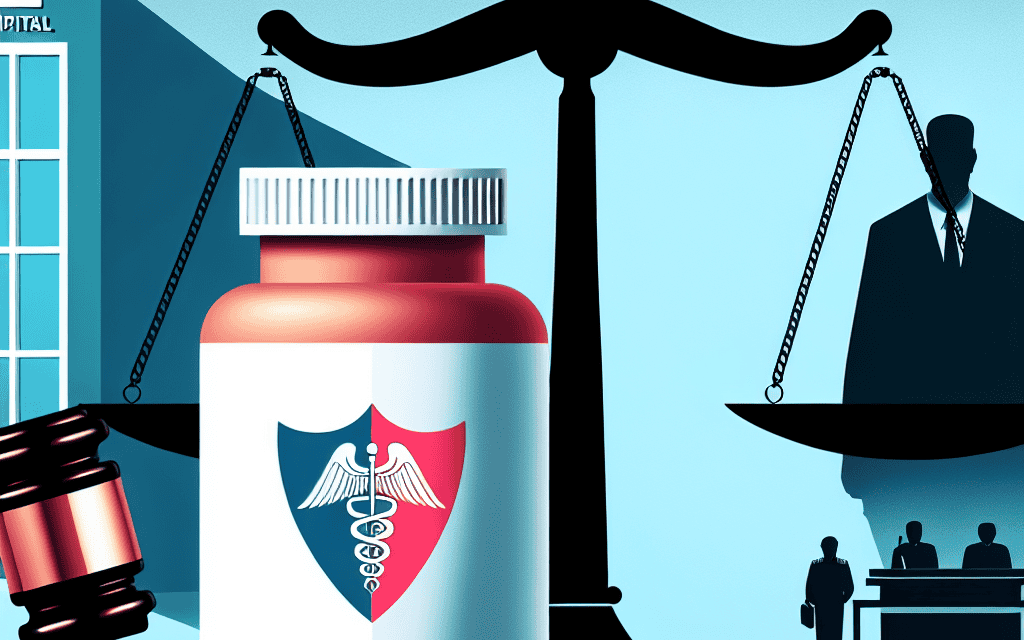Hospitals Aim to Intervene in J&J Lawsuit Against HHS to Safeguard Essential Drug Discounts
The healthcare landscape in the United States is constantly evolving, with various stakeholders vying for their interests in a complex system. One of the most pressing issues currently facing hospitals is the lawsuit filed by Johnson & Johnson (J&J) against the Department of Health and Human Services (HHS). This lawsuit threatens to undermine essential drug discounts that hospitals rely on to provide affordable care to their patients. In this article, we will explore the implications of this lawsuit, the motivations behind hospitals’ interventions, and the broader context of drug pricing in the U.S. healthcare system.
Understanding the Lawsuit: J&J vs. HHS
The lawsuit initiated by Johnson & Johnson against the HHS centers around the 340B Drug Pricing Program, a federal program designed to provide discounted medications to eligible healthcare organizations, including hospitals that serve low-income and uninsured patients. The program allows these hospitals to purchase drugs at significantly reduced prices, enabling them to stretch their resources and provide necessary care to vulnerable populations.
J&J’s lawsuit challenges the legality of certain provisions of the 340B program, arguing that the discounts offered to hospitals are excessive and detrimental to the pharmaceutical industry. The company contends that the program has been exploited by some hospitals, leading to financial losses for drug manufacturers. This legal battle has significant implications for the future of drug pricing and access to medications in the United States.
The 340B Drug Pricing Program: A Lifeline for Hospitals
The 340B program was established in 1992 as a response to rising drug costs and the need for safety-net providers to deliver care to underserved populations. Under this program, eligible hospitals can purchase outpatient drugs at reduced prices, which they can then dispense to patients at a lower cost. The savings generated from the program are crucial for many hospitals, particularly those serving low-income communities.
Key features of the 340B program include:
- Eligibility: Hospitals must meet specific criteria to participate, including being a disproportionate share hospital (DSH) or a critical access hospital (CAH).
- Discounts: The discounts can be substantial, often ranging from 20% to 50% off the average wholesale price of drugs.
- Use of Savings: Hospitals are encouraged to use the savings to enhance services, reduce patient costs, and expand access to care.
Despite its benefits, the 340B program has faced criticism from pharmaceutical companies, which argue that it leads to financial strain on their operations. J&J’s lawsuit is a manifestation of this ongoing tension between drug manufacturers and healthcare providers.
The Implications of the Lawsuit for Hospitals
The outcome of J&J’s lawsuit could have far-reaching consequences for hospitals across the country. If the court rules in favor of J&J, it could lead to significant reductions in the discounts available to hospitals under the 340B program. This would not only impact the financial stability of these institutions but also jeopardize their ability to provide essential services to their communities.
Some potential implications include:
- Increased Drug Costs: Hospitals may face higher drug acquisition costs, which could lead to increased prices for patients and reduced access to necessary medications.
- Service Reductions: With diminished financial resources, hospitals may be forced to cut back on services, impacting patient care and outcomes.
- Impact on Vulnerable Populations: The most affected will be low-income and uninsured patients who rely on these hospitals for affordable care.
As the lawsuit unfolds, hospitals are mobilizing to intervene and protect their interests, recognizing the critical role that the 340B program plays in their operations.
Hospitals’ Response: Mobilizing for Intervention
In light of the potential threats posed by J&J’s lawsuit, hospitals across the nation are taking proactive steps to intervene in the case. This mobilization reflects a growing recognition of the importance of the 340B program and the need to safeguard it against legal challenges.
Coalition Building Among Hospitals
One of the primary strategies employed by hospitals is the formation of coalitions to collectively address the challenges posed by the lawsuit. These coalitions often include a diverse range of stakeholders, including community hospitals, academic medical centers, and healthcare advocacy organizations. By coming together, hospitals can amplify their voices and present a united front in support of the 340B program.
Key aspects of coalition building include:
- Shared Resources: Hospitals can pool their resources to fund legal representation and advocacy efforts, ensuring that they have the necessary support to intervene effectively.
- Information Sharing: Coalitions facilitate the exchange of information and best practices among hospitals, helping them to navigate the complexities of the legal landscape.
- Advocacy Efforts: By working together, hospitals can engage in coordinated advocacy efforts to raise awareness about the importance of the 340B program and its impact on patient care.
These coalitions are not only focused on the legal aspects of the lawsuit but also on educating policymakers and the public about the critical role that the 340B program plays in ensuring access to affordable medications.
Legal Strategies for Intervention
As hospitals prepare to intervene in the lawsuit, they are exploring various legal strategies to protect their interests. This includes filing amicus curiae briefs, which allow third parties to provide their perspectives on the case. By submitting these briefs, hospitals can articulate the importance of the 340B program and its impact on patient care.
Some key legal strategies include:
- Highlighting Patient Impact: Hospitals can emphasize how changes to the 340B program would adversely affect patient access to medications and overall health outcomes.
- Demonstrating Financial Necessity: By providing data on how the 340B program supports their financial viability, hospitals can make a compelling case for the program’s continuation.
- Engaging Legal Experts: Collaborating with legal experts who specialize in healthcare law can enhance hospitals’ ability to navigate the complexities of the case.
Through these legal strategies, hospitals aim to ensure that their voices are heard in the courtroom and that the importance of the 340B program is recognized by the judiciary.
The Broader Context of Drug Pricing in the U.S.
The lawsuit filed by J&J against HHS is part of a larger conversation about drug pricing in the United States. The rising costs of prescription medications have become a significant concern for patients, healthcare providers, and policymakers alike. Understanding this broader context is essential for grasping the implications of the lawsuit.
The Rising Cost of Prescription Drugs
Over the past two decades, the cost of prescription drugs in the United States has skyrocketed, leading to increased financial burdens for patients and healthcare systems. According to a report from the Kaiser Family Foundation, prescription drug spending in the U.S. reached nearly $400 billion in 2020, with prices rising at a rate that outpaces inflation.
Several factors contribute to the rising cost of prescription drugs, including:
- Research and Development Costs: Pharmaceutical companies often cite high R&D costs as a justification for elevated drug prices, although the actual costs can vary significantly.
- Market Exclusivity: Patent protections allow drug manufacturers to maintain monopolies on certain medications, limiting competition and keeping prices high.
- Complex Supply Chains: The pharmaceutical supply chain is intricate, with multiple intermediaries involved, which can drive up costs for hospitals and patients.
The rising costs of prescription drugs have prompted calls for reform, with many advocating for greater transparency and regulation in drug pricing. The outcome of J&J’s lawsuit could have implications for these broader discussions about drug pricing reform.
The Role of Government Programs in Drug Pricing
Government programs like the 340B Drug Pricing Program play a crucial role in mitigating the impact of rising drug costs on hospitals and patients. By providing discounts to eligible healthcare providers, these programs help ensure that essential medications remain accessible to those who need them most.
However, the sustainability of these programs is under threat from legal challenges and industry pushback. As pharmaceutical companies seek to protect their profit margins, the future of programs like 340B hangs in the balance. The outcome of J&J’s lawsuit could set a precedent for how government programs are structured and implemented in the future.
Case Studies: The Impact of 340B on Hospitals
To illustrate the importance of the 340B program and the potential consequences of its disruption, it is helpful to examine case studies of hospitals that have benefited from the program. These examples highlight how the savings generated through 340B discounts have enabled hospitals to provide critical services to their communities.
Case Study 1: Community Hospital in Rural America
A community hospital in rural America serves a population with limited access to healthcare services. The hospital relies heavily on the 340B program to purchase essential medications at reduced prices. The savings generated from the program allow the hospital to offer a range of services, including outpatient care, emergency services, and chronic disease management.
Without the 340B program, the hospital would face significant financial challenges, potentially leading to service reductions or even closure. The program has enabled the hospital to invest in new technologies and expand its services, ultimately improving health outcomes for the community.
Case Study 2: Urban Safety-Net Hospital
An urban safety-net hospital serves a diverse population, including many low-income and uninsured patients. The hospital’s participation in the 340B program has been instrumental in its ability to provide affordable medications to patients who would otherwise struggle to afford them.
The hospital uses the savings from the 340B program to fund patient assistance programs, which help cover the costs of medications for those in need. Additionally, the program has allowed the hospital to invest in preventive care initiatives, reducing hospital readmissions and improving overall health outcomes.
Conclusion: The Future of Drug Pricing and Hospital Care
The lawsuit filed by Johnson & Johnson against the Department of Health and Human Services represents a critical juncture in the ongoing debate over drug pricing and access to medications in the United States. As hospitals mobilize to intervene in the case, they are not only protecting their interests but also advocating for the vulnerable populations they serve.
The outcome of this lawsuit could have far-reaching implications for the 340B Drug Pricing Program and the broader landscape of drug pricing reform. As stakeholders continue to navigate this complex issue, it is essential to prioritize patient access to affordable medications and ensure that healthcare providers have the resources they need to deliver high-quality care.
In summary, the interplay between pharmaceutical companies, government programs, and healthcare providers will shape the future of drug pricing in the United States. As hospitals work to safeguard essential drug discounts, they are also advocating for a healthcare system that prioritizes access, affordability, and equity for all patients.





